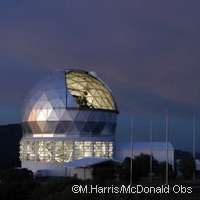Scientists discover ageing star destroys planet

(Phys.org)—An international team of astronomers has found evidence that a planet was destroyed by its ageing star. Led by Pennsylvania State University (Penn State) in the United States, the team showed that the missing planet was 'consumed' as the star expanded into a 'red giant', what experts refer to as the advanced age of stars.
Presented in the Astrophysical Journal Letters, the study was funded in part by the PLANES ('Unfolding the evolution of planetary systems') project.
'A similar fate may await the inner planets in our solar system, when the Sun becomes a red giant and expands all the way out to Earth's orbit some 5 billion years from now,' said co-author Alexander Wolszczan, Evan Pugh Professor of Astronomy and Astrophysics at Penn State University in the United States.
The researchers from Poland, Spain and the United States made their discovery after using the Hobby-Eberly Telescope to examine the ageing star and to investigate planets around it. Their results showed the strange chemical composition of the star, and a huge planet in an elliptical orbit around the same red giant star, called BD+48 740. Its radius is around 11 times bigger than the Sun.
'Our detailed spectroscopic analysis reveals that this red-giant star, BD+48 740, contains an abnormally high amount of lithium, a rare element created primarily during the Big Bang 14 billion years ago,' said lead author Dr Monika Adamow of Nicolaus Copernicus University in Poland.
Astronomers say lithium is easily destroyed in stars, making the researchers wonder why there was such a high quantity of lithium in the older star. 'Theorists have identified only a few, very specific circumstances, other than the Big Bang, under which lithium can be created in stars,' Dr Wolszczan pointed out. 'In the case of BD+48 740, it is probable that the lithium production was triggered by a mass the size of a planet that spiralled into the star and heated it up while the star was digesting it.'
With respect to the highly elliptical orbit of the star's newly discovered planet, the astronomers said the planet revolves around the star in an orbit that is just wider than that of Mars at its narrowest point. 'But it is much more extended at its farthest point,' said Dr Andrzej Niedzielski of Nicolaus Copernicus University. 'Such orbits are uncommon in planetary systems around evolved stars and, in fact, the BD+48 740 planet's orbit is the most elliptical one detected so far.'
According to the team, gravitational interactions between planets generate the unusual orbits. So the 'dive of the missing planet toward the star before it became a giant could have given the surviving massive planet a burst of energy, throwing it into an eccentric orbit like a boomerang', they explained.
'Catching a planet in the act of being devoured by a star is an almost improbable feat to accomplish because of the comparative swiftness of the process, but the occurrence of such a collision can be deduced from the way it affects the stellar chemistry,' said Eva Villaver of the Universidad Autonoma de Madrid in Spain. 'The highly elongated orbit of the massive planet we discovered around this lithium-polluted red-giant star is exactly the kind of evidence that would point to the star's recent destruction of its now-missing planet.'
More information: Adamow, M., et al. 'BD+48 740-Li overabundant giant star with a planet: a case of recent engulfment?' ApJ, 2012, 754. doi:10.1088/2041-8205/754/1/l15
Journal information: Astrophysical Journal Letters
Provided by CORDIS


















